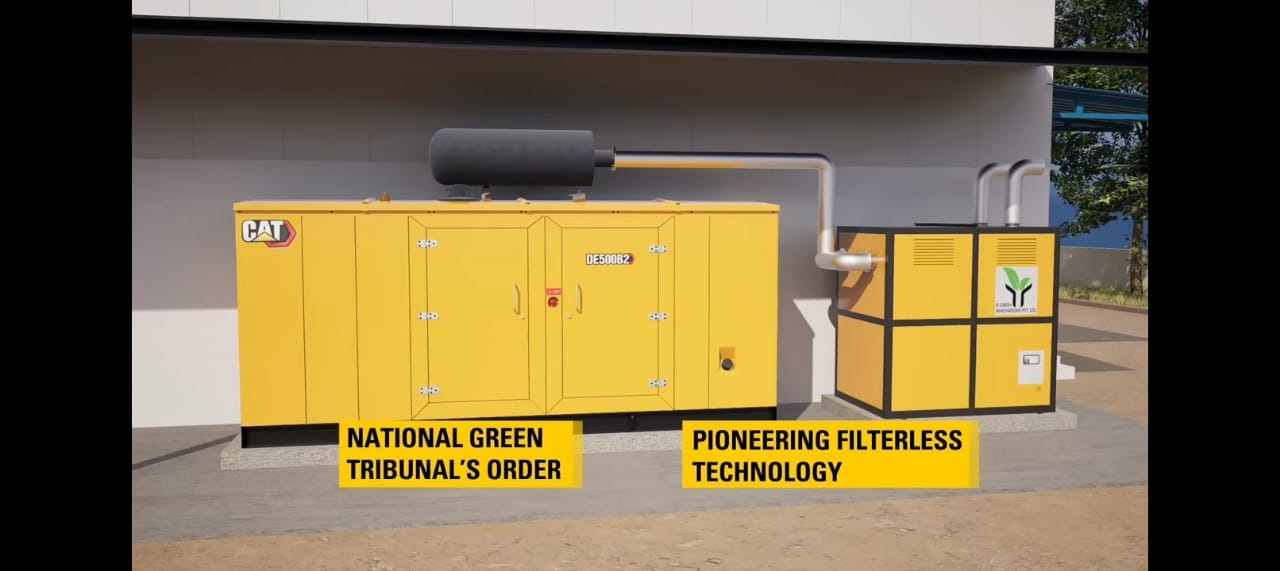Table of Contents
Retrofit Emission Control Devices:
Clean air is not just important. It is life. Every breath we take should be pure and safe. But sadly, the air around us is filled with harmful gases and tiny particles. These come from vehicles, factories, and other machines that burn fuel. One strong and smart solution to reduce this pollution is the use of Retrofit Emission Control Devices.
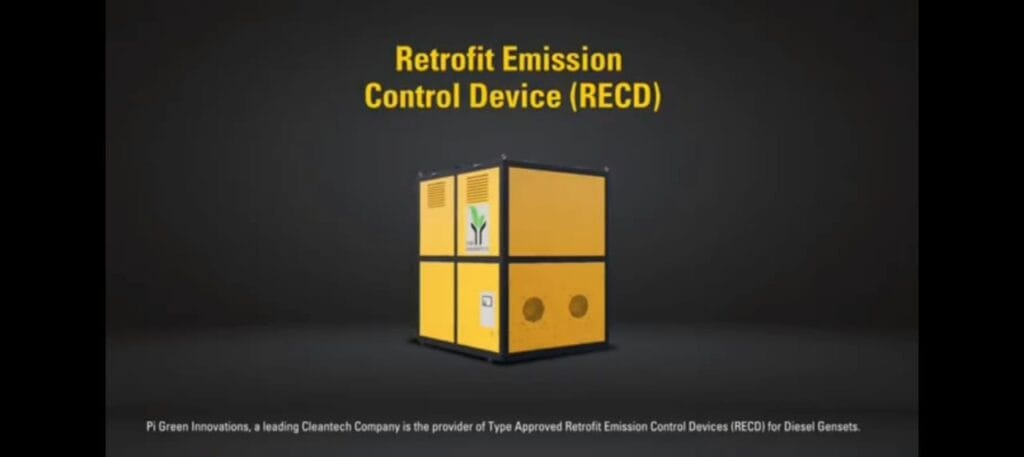
What is RECD?
A Retrofitted Emission Control Device (RECD) is a special device installed in diesel generator sets to reduce harmful exhaust emissions, especially particulate matter (PM). It helps make older DG sets more environmentally friendly and compliant with pollution control norms.
What Are Retrofit Emission Control Devices?
Retrofit Emission Control Devices, or RECDs, are smart pollution-reducing tools that can be added to older vehicles and machines. They are designed to clean the harmful gases and particles that come out of the engine’s exhaust. Think of it as a powerful air purifier, but for your car, truck, bus, generator, or construction equipment.
When a machine burns fuel—like diesel or petrol—it creates exhaust. This exhaust contains black smoke (soot), poisonous gases like carbon monoxide (CO), nitrogen oxides (NOx), and other tiny particles that float in the air. These are harmful to human health and the environment.
RECDs are installed on the exhaust pipe or system. As the exhaust passes through the RECD, it goes through filters, catalysts, and sometimes chemical sprays. These parts work together to trap solid particles, convert harmful gases into safer ones, and reduce the overall pollution.
There are different types of RECDs for different types of engines, but they all have the same goal: to make dirty exhaust cleaner before it reaches the open air.
Using RECDs is like giving old engines a cleaner voice. They still run, still work hard—but now they do it more responsibly, without harming the air we breathe.
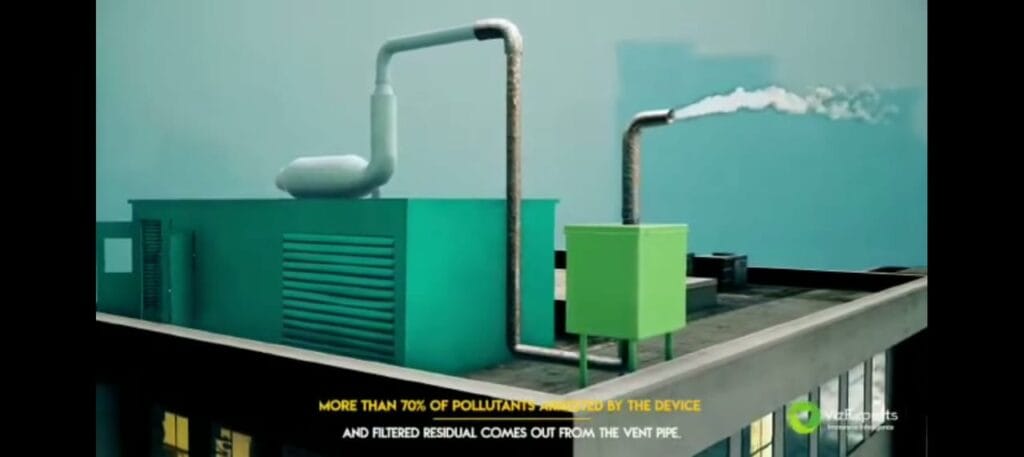
Why Do We Need RECDs?
In the past, vehicles and machines were built without knowing how harmful their smoke could be. Their engines burned fuel, and the smoke—full of black soot and poisonous gases—went straight into the air. Back then, there were no rules or systems to clean it.
Now, we know better. Scientists have shown that this pollution causes asthma, lung infections, heart problems, and even early death. Pollution doesn’t just hurt people—it harms plants, animals, rivers, and even the climate.
But here’s the problem: millions of these old machines still exist. They still work, and people rely on them every day—in transport, farming, construction, and industry. Throwing them away would create a huge waste of money, metal, and energy. It would also create new pollution from making brand-new machines.
That’s why Retrofit Emission Control Devices (RECDs) are so important. They give us a smarter way to solve this problem.
Instead of replacing old machines, we improve them. By adding RECDs, we clean the exhaust and reduce pollution. It’s like giving the machine a mask that filters out the harmful stuff. It’s cheaper, faster, and better for the planet.
RECDs are not just a tool—they are a bridge. A bridge between the past (old machines) and the future (clean air). They let us move forward without leaving anyone behind. And in a world where every breath matters, that is a very big deal.
Replacing them with new, eco-friendly versions can be extremely expensive. It also leads to waste, because the old machines still have life left in them. Instead of throwing them away, we can make them cleaner. That’s what RECDs do. They transform polluting engines into cleaner ones—saving money, time, and the environment.
Installing RECDs is like giving old engines a second chance to live responsibly. They trap soot, reduce poisonous gases, and turn harmful chemicals into harmless ones. It’s like fitting a smart cleaning system into an old engine’s exhaust. And this small change creates a big impact.
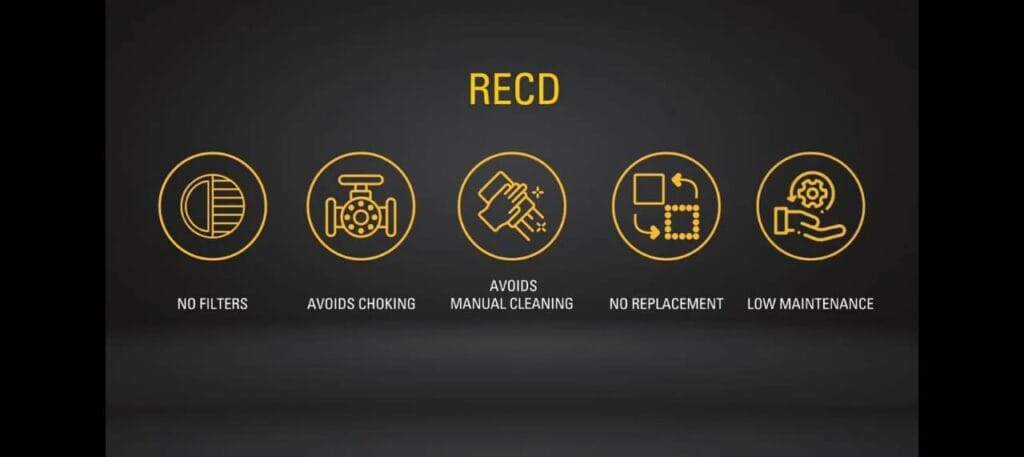
How Do RECDs Work?
Retrofit Emission Control Devices work like smart air cleaners for machines. When a vehicle or a diesel engine runs, it burns fuel. This process creates gases and particles that are harmful to humans, animals, and plants. These gases flow out through the exhaust pipe, and if left untreated, they pollute the air we breathe.
RECDs are attached to the exhaust system. As the dirty gases pass through the device, the RECD filters and treats them using different techniques. Here is how it works in a deeper and simple way:
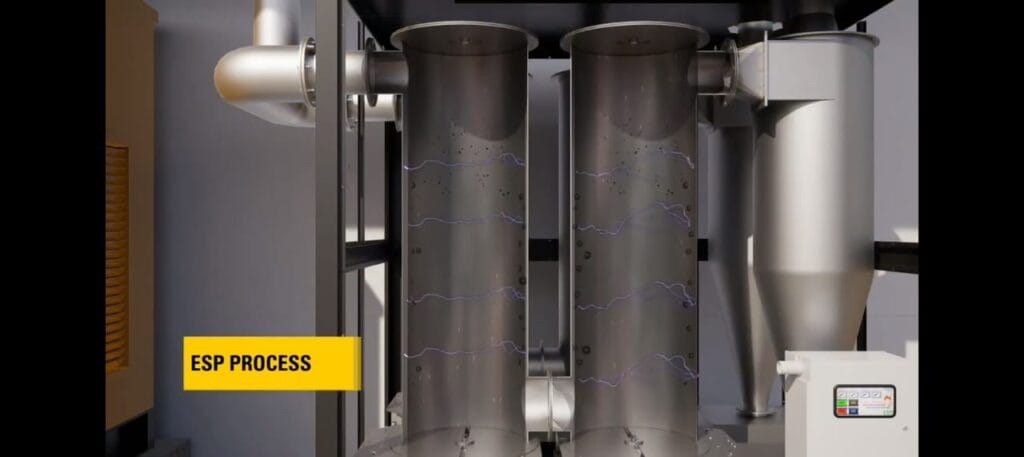
- Black Smoke (Soot): This smoke is made up of tiny unburnt fuel particles. RECDs trap these using fine filters called Diesel Particulate Filters (DPFs). These filters catch the particles and stop them from entering the air.
- Carbon Monoxide (CO): This gas has no smell or color, but it is poisonous. RECDs use a special part called a catalyst to change carbon monoxide into carbon dioxide, which is much safer.
- Nitrogen Oxides (NOx): These gases cause breathing problems and even acid rain. RECDs like Selective Catalytic Reduction (SCR) systems spray a harmless liquid (called urea or DEF) into the exhaust. This liquid reacts with NOx and turns it into nitrogen and water vapor.
- Tiny Dust Particles: These can go deep into our lungs and make us sick. RECDs have advanced filters that trap these particles just like a vacuum cleaner bag catches dust.
Many RECDs also have sensors and control systems. These check how much gas is going through, how hot it is, and whether the filter needs cleaning. Some RECDs can even clean themselves when they get too full—a process called regeneration.
In short, RECDs act like protectors at the gate, stopping harmful pollution from escaping into the air. They quietly and efficiently clean up the mess that engines leave behind, making the world safer for all of us.
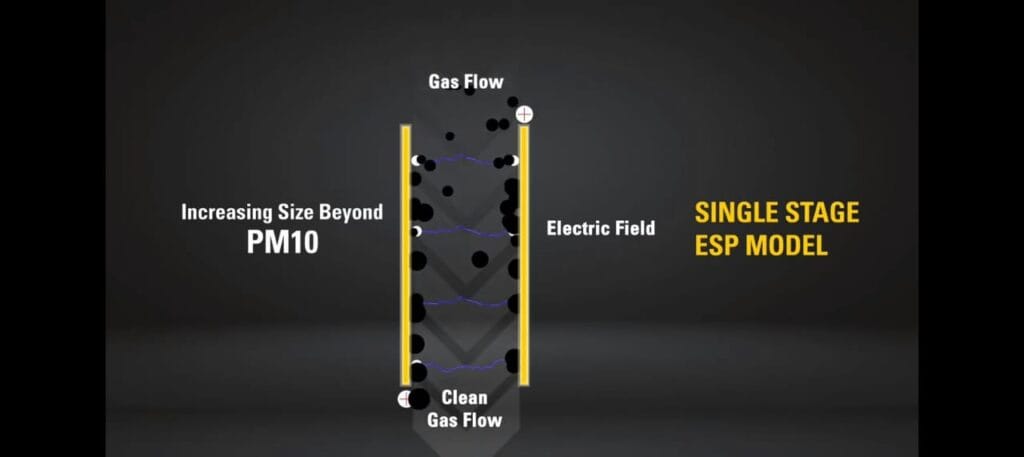
Types of Retrofit Emission Control Devices
There are many types of RECDs. Each one has a unique role and works in its own special way to clean up the dirty gases from engines. Let’s look at them one by one, in a deep and simple way:
- Diesel Particulate Filters (DPFs): These are like very fine nets placed inside the exhaust system. As black smoke (soot) tries to pass through, the DPF catches and holds these tiny particles. After a while, the filter fills up. That’s when the DPF cleans itself by burning the soot at high temperatures in a process called “regeneration.” This turns the harmful soot into harmless ash or gases. Without a DPF, diesel engines release large clouds of black smoke that harm our lungs and make the air dirty.
- Diesel Oxidation Catalysts (DOCs): DOCs are like small chemical factories inside the exhaust pipe. They use special metals like platinum or palladium to cause chemical reactions. These reactions change harmful gases like carbon monoxide (CO) and hydrocarbons (HC) into carbon dioxide (CO₂) and water vapor. This is very important because carbon monoxide is a silent killer—colorless, odorless, but very dangerous. The DOC helps make the air safer with every engine run.
- Selective Catalytic Reduction (SCR): SCR is a smart and modern type of RECD. It doesn’t just trap gases—it changes them completely. It works with a special liquid called Diesel Exhaust Fluid (DEF), usually made of urea. This fluid is sprayed into the exhaust gases. Then, inside the SCR device, a chemical reaction happens that turns harmful nitrogen oxides (NOx) into nitrogen (which we already breathe) and water vapor. It’s like magic—but it’s science. SCR systems can reduce nitrogen oxides by up to 90% if properly maintained.
- Exhaust Gas Recirculation (EGR): EGR is a clever trick. It takes a small amount of used exhaust gas and sends it back into the engine’s air intake. This makes the combustion process cooler, which lowers the formation of nitrogen oxides. When the engine burns fuel at lower temperatures, fewer harmful gases are created. EGR works quietly and constantly as the engine runs, helping reduce pollution from the very start.
Together, these devices create a powerful system that makes engines much cleaner and safer for everyone. They each do a different job, but all of them work toward the same goal: clean air and healthy living.
Benefits of Using RECDs
- Cleaner Air: RECDs remove harmful gases and soot from the air. This means the air we breathe becomes fresher and safer. Imagine living in a city where the sky is always blue and clear. RECDs make this possible by cleaning the smoke from old engines and machines before it reaches the air.
- Better Health: Pollution affects our lungs, heart, and even our brain. Children breathe faster and take in more air, which means they are more affected by pollution. Older people, who may already have weak lungs, also suffer more. RECDs reduce the harmful substances in the air, helping everyone breathe better and stay healthier. Clean air can prevent coughs, asthma, and many serious diseases.
- Cost Saving: Replacing an old vehicle or machine is very expensive. RECDs allow us to keep using the same machines safely by updating their emission systems. This saves money for families, companies, and even governments. It’s like giving old engines a new life instead of throwing them away.
- Eco-Friendly: The earth is our home, and it needs our help. Pollution from vehicles causes damage to plants, animals, and weather patterns. By using RECDs, we reduce pollution and protect nature. Trees grow better, rivers stay cleaner, and animals live healthier lives when the air is not full of smoke.
- Supports Rules: Governments around the world are making laws to fight pollution. By using RECDs, people and companies follow these laws and avoid fines. It also shows responsibility and care for the environment. When rules are followed, everyone wins—our health, our future, and our planet.
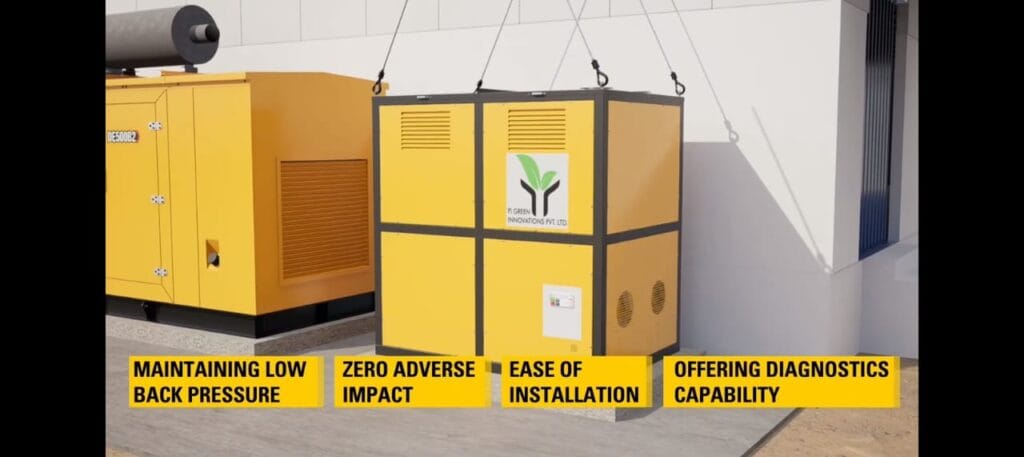
Where Are RECDs Used?
RECDs are very flexible tools. They can be used in many different machines that burn fuel and release smoke. Here’s a deeper look into where and how these devices are used:
Old Buses and Trucks: These vehicles often run on diesel and travel long distances every day. Over time, their engines wear out and produce more smoke. RECDs help clean their exhaust and reduce pollution in busy cities and highways. Many public transport systems are now using RECDs to reduce the pollution that affects millions of daily passengers.
Construction Machines: Big machines like bulldozers, excavators, and cranes use a lot of fuel and work on construction sites for hours. These areas are often close to homes and schools. RECDs help control the black smoke these machines produce, protecting workers and nearby families from harmful air.
Diesel Generators: In places where electricity is not always available, diesel generators are used. These machines can produce heavy smoke if not controlled. Installing RECDs in these generators can greatly reduce pollution in homes, shops, hospitals, and schools.
Old Cars: While modern cars have built-in emission controls, older models do not. These cars can be retrofitted with RECDs to reduce their pollution and extend their use. This is especially helpful for people who can’t afford new vehicles but still want to help protect the environment.
Farming Equipment: Tractors and harvesters used in farming often release thick exhaust into the open air. Adding RECDs to these machines protects both farmers and crops from harmful gases.
Boats and Ferries: Water vehicles with diesel engines can pollute both air and water. By using RECDs, we can protect not just the sky, but also rivers and lakes.
In short, RECDs can be used almost anywhere there is a fuel-burning engine. Whether it’s on land or water, in cities or villages, RECDs are powerful tools that help us reduce pollution, breathe cleaner air, and create a safer world for all.
Installing RECDs
Installing a retrofit emission control device (RECD) is a step-by-step process that must be done with care and expertise. It is not simply about attaching a device; it is about making sure the device works perfectly with the engine to clean the exhaust gases effectively. Here’s a deeper look into how installation works:
Assessment of the Engine: First, the engine must be checked. What kind of fuel does it use? How much smoke does it produce? How old is the engine? This information helps decide which type of RECD is best.
Matching the Right Device: Not all RECDs fit all engines. Choosing the wrong device may damage the engine or fail to clean the air. Experts select the RECD that matches the size, type, and condition of the engine.
Installation by Experts: Installing an RECD is a technical job. Trained engineers or mechanics open the exhaust system and fix the RECD carefully. They must seal it tightly so that no smoke escapes without passing through the device.
Electrical Connections (if needed): Some advanced RECDs have sensors or heaters. These need proper electrical connections to the engine system so that they can work automatically and safely.
Testing After Installation: Once the RECD is installed, it must be tested. This test checks if the device is reducing pollution properly. It also checks if the engine is still running smoothly. If there’s any trouble, the experts fix it on the spot.
Documentation and Approval: In many places, after installation, an emission test report is needed. This proves that the engine now meets clean-air standards. It’s like getting a certificate that your machine is now safe for the environment.
In simple words, installing an RECD is like giving your engine a new, cleaner lung. It helps the engine breathe better and pollute less. But this job must be done properly, with care and knowledge, to make sure the air really gets cleaner.
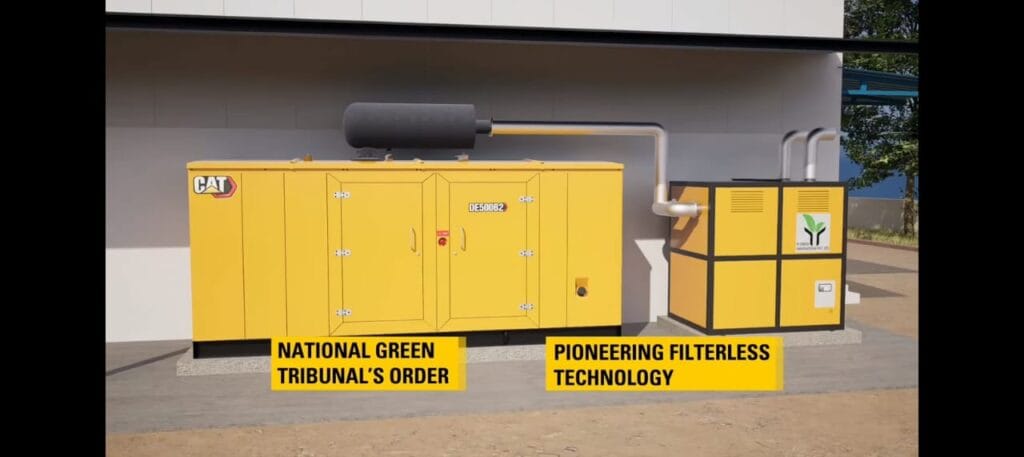
Maintenance of RECDs
Retrofit Emission Control Devices are powerful tools, but to keep working well, they need regular attention—just like we take care of our health or keep our homes clean. A well-maintained RECD not only lasts longer but also keeps cleaning the air properly every day. Here’s a deeper look into how to maintain these devices:
Clean Filters Regularly: Many RECDs, like Diesel Particulate Filters (DPFs), trap soot and black smoke. Over time, these filters fill up. If not cleaned, they block airflow and stop working. Some filters clean themselves using high heat, but others need manual cleaning by trained technicians. It’s like changing an air purifier filter to keep your room fresh.
Check for Damage: Engines vibrate, roads are bumpy, and heat builds up. This can damage pipes, sensors, or seals in the RECD system. Regular inspections help spot small problems before they become big ones. For example, a small crack in the device can let dirty smoke escape directly into the air. That’s why physical checks are important.
Follow Service Schedule: Every RECD comes with a recommended service plan. This tells you when to clean, inspect, or replace parts. Ignoring this schedule can reduce the device’s life and pollute more than it should. Regular servicing ensures the device keeps performing at its best.
Use Good Quality Fuel: Poor fuel can clog filters and damage sensitive parts. Clean fuel ensures less soot, which means the RECD has less to clean. It’s like feeding your body with healthy food—you feel better and work better.
Record Maintenance Work: Keeping a simple notebook or digital record of when maintenance was done helps track the health of the device. It also helps during inspections or government checks.
Taking care of RECDs is not difficult. It just needs some time, discipline, and care. In return, we get cleaner air, healthier lives, and longer-lasting engines. It’s a small effort for a big reward.
Challenges of RECDs
Retrofit Emission Control Devices are very helpful, but like all good things, they also come with some challenges. These challenges don’t mean we should avoid using RECDs. Instead, we should understand them better so we can solve or reduce them. Let’s look at these issues more deeply:
High Cost at the Start: Installing an RECD is an investment. The equipment itself, along with professional installation, can cost a lot—especially for large engines or fleets. For small business owners or farmers, this cost may feel heavy at first. However, this is a one-time cost that pays off over time through cleaner air, better health, and avoiding government fines.
Need for Regular Cleaning: Some RECDs need frequent maintenance. For example, Diesel Particulate Filters (DPFs) fill up with soot and must be cleaned regularly. If ignored, the device can get blocked and stop working. This means users must follow a service schedule carefully and sometimes stop work to get the system cleaned. But this small pause prevents big pollution.
Fuel Quality Affects Performance: RECDs work best when the fuel is clean. If dirty or low-quality fuel is used, it can produce more soot and even damage the sensitive parts inside the device. In some areas, especially rural ones, clean fuel may not always be available. This makes it harder to keep the RECD running smoothly. However, using filters in fuel tanks or buying cleaner fuel when possible can help.
Space and Fitting Issues: Some old machines or vehicles may not have enough space for a new RECD. Adjustments need to be made, which could take extra time and skill. In some cases, very old engines may need small redesigns to accept the device.
Lack of Awareness and Skilled Technicians: In many places, people do not know much about RECDs or how to maintain them. Skilled professionals are also not available everywhere. This can lead to improper installation or missed maintenance. Awareness programs and training can solve this problem over time.
Despite these challenges, the overall benefits of RECDs are much bigger. Clean air, better health, longer engine life, and a safer planet are priceless gifts. With the right planning and care, we can overcome these challenges and build a cleaner future for all.
RECDs and the Future
Our world is going through a major change. People everywhere are realizing how dangerous pollution is—for our health, our environment, and our future. Children are learning about clean air in school. Doctors are warning about diseases caused by bad air. And governments are creating stricter laws to reduce emissions from vehicles and machines.
In this changing world, Retrofit Emission Control Devices (RECDs) are becoming more important than ever. They offer a smart and practical way to fight pollution without having to destroy or replace every old engine or machine. Instead of throwing away valuable machines that still work, we can make them cleaner and safer by adding RECDs.
This approach not only saves money but also helps us reduce waste. Making a new vehicle or machine uses a lot of materials and energy. By retrofitting old ones, we protect both the air and the earth’s natural resources.
RECDs also help us meet the strict environmental rules that are coming into effect across the world. Countries are setting emission limits and deadlines for pollution control. With RECDs, companies, transport systems, and even individual vehicle owners can follow these rules without huge expenses.
Looking ahead, RECDs will become part of our everyday lives. They will be used in buses, construction machines, farm equipment, generators, and even boats. They will also encourage the development of new jobs in installation, maintenance, and education about clean air technology.
In short, RECDs are not just tools—they are keys to a cleaner, healthier, and smarter future.
A Message of Hope
Clean air is a right, not a gift. We can all help by supporting and using technologies like Retrofit Emission Control Devices. These devices are not just machines. They are protectors of life, health, and the future.
Let us work together for a world where every child can breathe fresh air, where machines run cleanly, and where we all live healthier lives.
FAQ
What is a Retrofit Emission Control Device (RECD)?
A Retrofit Emission Control Device is a system installed in vehicles or machines to reduce harmful exhaust emissions. It helps clean the air by removing pollutants like soot, carbon monoxide, and harmful gases.How does an RECD work?
An RECD works by trapping or converting harmful pollutants in the exhaust into less harmful substances. It uses filters, catalysts, or chemical processes to clean the emissions before they go into the air.Why are RECDs important?
RECDs help reduce air pollution, protect public health, and support a cleaner environment. They are especially useful for older diesel vehicles that release more pollution.
How is an RECD installed?
RECDs are usually fitted to the exhaust system of the engine. A professional checks the engine type, space, and emission levels before installation. Some devices may need electronic connections or urea tanks (in SCR systems).What types of RECDs are available?
Diesel Particulate Filters (DPF): Capture soot and black smoke
Diesel Oxidation Catalysts (DOC): Break down carbon monoxide and hydrocarbons
Selective Catalytic Reduction (SCR): Reduces nitrogen oxides using urea solution
Exhaust Gas Recirculation (EGR): Lowers NOx by recirculating exhaust gases

